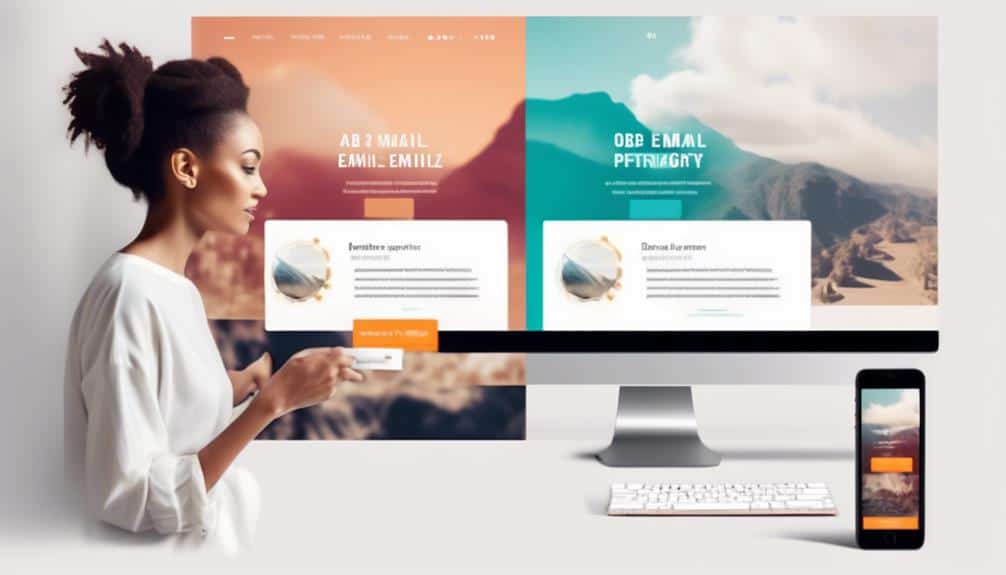Warning: Are You Ignoring These Crucial A/B Testing Methods for Your Emails?
Are you truly maximizing the potential of your email marketing campaigns?
It is a well-known fact that A/B testing can greatly enhance the effectiveness of your emails, but are you neglecting some crucial methods that could take your campaigns to the next level?
In this discussion, we will explore a variety of A/B testing techniques that are often overlooked, leaving you hanging with the anticipation of discovering how these methods can revolutionize your email marketing strategy.
Key Takeaways
- Subject line testing, including the use of emojis and personalization, can optimize open rates and engagement.
- Call to action testing, including button color and placement, can significantly impact click-through rates.
- A/B testing is crucial for determining the most effective button color, CTA format, and email design elements.
- Tracking click-through rates and conversions is essential for measuring the success of email testing methods.
Subject Line Testing

To optimize the effectiveness of your email campaigns, subject line testing is a crucial strategy that allows you to analyze and refine the impact of different subject lines on open rates and engagement.
One effective method of subject line testing is email preview testing. This involves sending test emails to various devices and email clients to ensure that your subject line appears as intended and isn't cut off or distorted. By conducting email preview testing, you can ensure that your subject line is visually appealing and effectively captures the attention of your recipients.
Another element to consider in subject line testing is emoji usage. Emojis can add visual appeal and convey emotions, making your subject line more engaging and memorable. However, it's important to test the impact of emojis on your specific audience. Some studies have shown that emojis can increase open rates, while others have found no significant impact. By conducting A/B tests with and without emojis, you can determine whether they enhance or hinder the performance of your subject lines.
Call to Action Testing
When it comes to testing your email's call to action (CTA), there are three key points to consider.
First, the color of your CTA button can have a significant impact on click-through rates.
Second, you should test whether a text-based CTA or an image-based CTA performs better for your audience.
Lastly, the placement and visibility of your CTA within the email can greatly influence its effectiveness.
Button Color Impact
Testing the impact of button color on email conversions can provide valuable insights for optimizing call to action effectiveness.
While button size and font style are important factors to consider when designing a call to action, the color of the button can have a significant impact on user behavior. Research has shown that certain colors evoke different psychological responses and can influence the decision-making process.
For example, using a contrasting color for the button can make it more noticeable and increase click-through rates. However, it's crucial to conduct A/B testing to determine the most effective color for your specific audience.
Text Vs. Image CTA
Understanding the impact of different call to action formats is crucial for optimizing email conversions. One key aspect to consider is whether to use text or image for your CTA.
Here is a conversion rate analysis comparing the performance of text and image CTAs:
- Text CTAs: Text-based call to actions are simple and easy to read. They can blend seamlessly into the email content, making them less obtrusive. However, they mightn't grab attention as effectively as visual elements.
- Image CTAs: Image-based call to actions can be visually appealing and eye-catching. They can use colors, graphics, and buttons to create a sense of urgency and drive action. However, they may be blocked by email clients or not display properly on certain devices.
- Conversion rates: Analyzing the performance of text and image CTAs through A/B testing can provide valuable insights into which format resonates better with your audience. It's essential to track click-through rates, engagement, and overall conversions to determine the most effective approach.
- Finding the right balance: Consider using a combination of both text and image CTAs to cater to different preferences and optimize conversions. A balanced approach allows you to leverage the strengths of each format while catering to a wider range of recipients.
Placement and Visibility
To optimize your email conversions, it's crucial to test the placement and visibility of your call to action (CTA). The position and prominence of your CTA can significantly impact the click-through rates and overall success of your email campaigns.
Here are two key factors to consider when testing the placement and visibility of your CTA:
- Font size optimization: Test different font sizes for your CTA to find the optimal size that grabs attention without overwhelming the reader. A larger font size may make the CTA more noticeable, but it should still be readable and in line with your email's design.
- Email header testing: Experiment with placing your CTA in different sections of the email header, such as at the top or bottom, to determine which placement drives the highest engagement. Consider testing variations with and without additional header elements like logos or images to see what captures attention best.
Email Design Testing
Are you maximizing the impact of your email designs through rigorous testing? Email design testing is a crucial step in optimizing the effectiveness of your email campaigns. By testing different elements of your email layout and font selection, you can ensure that your emails are visually appealing, easy to read, and engaging for your audience.
Here are four key areas to focus on when conducting email design testing:
- Layout: Test different email layouts to determine which one resonates best with your audience. Consider variations in the placement of images, text, and call-to-action buttons to find the optimal arrangement that drives the desired action.
- Font selection: Experiment with different fonts to find the one that enhances readability and aligns with your brand identity. Test variations in font size, color, and style to ensure your emails are visually appealing and easy to digest.
- Color scheme: Test different color schemes to create a visually appealing email that aligns with your brand. Colors can evoke certain emotions and influence readers' perception of your message, so it's important to find the right combination that effectively conveys your intended message.
- Mobile optimization: With the majority of emails being opened on mobile devices, it's crucial to test how your email design translates across different screen sizes. Ensure that your email is responsive and displays properly on various devices to maximize engagement.
Personalization Testing

When it comes to personalization testing for your email campaigns, there are three key points to consider.
First, subject line personalization can significantly impact open rates by making your emails feel more personalized and relevant to the recipient.
Second, dynamic content customization allows you to tailor the content within your emails based on individual preferences or behaviors, increasing engagement and conversion rates.
Finally, segment-based email targeting enables you to send highly targeted messages to specific groups of subscribers, improving overall campaign performance.
Subject Line Personalization
Increase your email open rates and engagement by implementing subject line personalization through A/B testing methods. Subject line optimization is a crucial aspect of email marketing that can significantly impact the success of your campaigns.
Here's why you should consider subject line personalization:
- Increased Relevance: Personalized subject lines make your emails more relevant to individual recipients, capturing their attention and increasing the chances of them opening your message.
- Improved Engagement: When your subject line speaks directly to the recipient's interests or needs, they're more likely to engage with your email, leading to higher click-through rates and conversions.
- Enhanced Trust and Credibility: Personalization shows that you understand your audience and care about their specific needs, building trust and credibility with your subscribers.
- Segmentation Opportunities: A/B testing subject line personalization allows you to identify which personalized elements resonate best with different segments of your audience, enabling you to refine your targeting strategies.
Dynamic Content Customization
To optimize your email campaigns and increase engagement, dynamic content customization through personalization testing is a powerful method to consider. Email personalization effectiveness has been proven time and again, with studies showing that personalized emails have higher open rates, click-through rates, and conversion rates. By tailoring your content to each individual recipient, you can create a more relevant and engaging email experience.
The benefits of dynamic content in email marketing are numerous. Not only does it allow you to deliver personalized content, but it also enables you to automate the process, saving you time and effort. With dynamic content, you can easily create targeted messages based on factors such as demographics, past purchases, browsing behavior, and more. This level of customization increases the chances of your emails resonating with your audience and driving them to take the desired action.
Consider the following table to understand the impact of dynamic content customization:
| Benefits of Dynamic Content Customization |
|---|
| Higher open rates |
| Increased click-through rates |
| Improved conversion rates |
| Enhanced customer experience |
| Increased customer loyalty |
Segment-Based Email Targeting
By leveraging segment-based email targeting, you can further optimize your email campaigns and enhance personalization testing to deliver highly relevant content to your audience. Segment-based email personalization offers several benefits for targeted email campaigns:
- Increased engagement: By tailoring your emails to specific segments of your audience, you can deliver content that resonates with their unique needs and interests. This leads to higher open rates, click-through rates, and overall engagement.
- Improved conversion rates: When your emails are personalized and relevant, recipients are more likely to take the desired action, whether it's making a purchase, signing up for a webinar, or downloading a resource. This ultimately boosts your conversion rates.
- Enhanced customer satisfaction: By sending targeted emails, you show your audience that you understand their preferences and value their individuality. This personalized approach leads to higher customer satisfaction and loyalty.
- Better ROI: Segment-based email targeting allows you to allocate your resources more efficiently by focusing on the segments that are most likely to convert. This results in a higher return on investment for your email campaigns.
Timing and Frequency Testing

Timing and frequency testing plays a crucial role in optimizing email performance. When it comes to sending emails, finding the right time to reach your audience is essential. Through timing optimization, you can identify the most effective moments to send your emails, increasing the chances of them being opened and engaged with.
It's important to analyze your audience's behavior and preferences to determine the optimal timing for sending your emails. This can be done through frequency analysis, which helps you understand how often your audience wants to hear from you. By finding the right balance, you can avoid overwhelming your subscribers with too many emails or being forgotten by sending too few.
Content Testing
With timing and frequency testing optimized, the next step is to evaluate the effectiveness of your email content. Content testing plays a crucial role in conversion rate optimization and email engagement analysis. Here are four key methods to consider:
- Subject Line Testing: Experiment with different subject lines to determine which ones generate higher open rates. Test variations in length, tone, personalization, and urgency to find the most compelling subject line for your audience.
- Call-to-Action (CTA) Testing: Test different CTAs to determine which ones drive higher click-through rates. Experiment with variations in wording, color, size, and placement of your CTAs to optimize engagement and conversions.
- Personalization Testing: Evaluate the impact of personalization on your email performance. Test personalized content, such as using the recipient's name or location, to see if it improves open rates, click-through rates, and overall engagement.
- Content Length Testing: Experiment with different lengths of email content to determine what resonates best with your audience. Test shorter emails with succinct messaging against longer emails with more detailed information to find the optimal length for driving conversions.
Frequently Asked Questions
What Is the Purpose of A/B Testing in Email Marketing?
The purpose of A/B testing in email marketing is to improve the effectiveness of your campaigns by comparing different elements and strategies. It is crucial to test and optimize your emails to maximize engagement and conversions.
How Can Subject Line Testing Improve Email Open Rates?
Improve your email open rates by optimizing subject lines through A/B testing. This method allows you to test different subject line variations and determine the most effective one for maximum engagement.
What Are Some Common Mistakes to Avoid When Conducting Call to Action Testing?
When it comes to call to action testing, it's important to avoid common mistakes. Testing different CTAs can help you optimize your emails and improve conversion rates. Don't miss out on the opportunity to maximize your email marketing efforts.
How Can Personalization Testing Enhance the Effectiveness of Email Campaigns?
To enhance the effectiveness of your email campaigns, utilize personalization testing. Implement personalization strategies and segmentation techniques to deliver targeted content and increase engagement. Don't miss out on the opportunity to connect with your audience on a deeper level.
Are There Any Specific Best Practices for Timing and Frequency Testing in Email Marketing?
When it comes to email marketing, optimizing frequency and timing is crucial. By conducting A/B tests, you can determine the best frequency for sending emails and identify the optimal time to reach your audience.
Conclusion
Make sure you're not overlooking these vital A/B testing methods for your emails.
Subject line testing allows you to optimize open rates, while call to action testing can boost click-through rates.
Email design testing ensures your layout and visuals are engaging, and personalization testing helps you connect with your audience on a deeper level.
Timing and frequency testing helps you find the sweet spot for sending your emails, and content testing lets you refine your messaging for maximum impact.
Don't miss out on these opportunities to optimize your email campaigns and drive better results.








